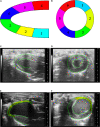Short-Term Inhalation of Ultrafine Zinc Particles Could Alleviate Cardiac Dysfunctions in Rats of Myocardial Infarction
- PMID: 33937215
- PMCID: PMC8081065
- DOI: 10.3389/fbioe.2021.646533
Short-Term Inhalation of Ultrafine Zinc Particles Could Alleviate Cardiac Dysfunctions in Rats of Myocardial Infarction
Abstract
It is not clear for inhalation of ultrafine metal particles in air pollution to impair human health. In the study, we aimed to investigate whether short-term (4 weeks) inhalation of ultrafine zinc particles could deteriorate the cardiac and hemodynamic functions in rats of myocardial infarction (MI). MI was induced in Wistar rats through coronary artery ligation surgery and given an inhalation of ultrafine zinc particles for 4 weeks (post-MI 4 weeks, 4 days per week, and 4 h per day). Cardiac strain and strain rate were quantified by the speckle tracking echocardiography. The pressure and flow wave were recorded in the carotid artery and analyzed by using the Womersley model. Myocardial infarction resulted in the LV wall thinning, LV cavity dilation, remarkable decrease of ejection fraction, dp/dt Max, -dp/dt Min, myocardial strain and strain rates, and increased LV end-diastolic pressure, as well as impaired hemodynamic environment. The short-term inhalation of ultrafine zinc particles significantly alleviated cardiac and hemodynamic dysfunctions, which could protect from the MI-induced myocardial and hemodynamic impairments albeit it is unknown for the long-term inhalation.
Keywords: Womersley analysis; myocardium infraction; speckle-tracing echocardiography; strain analysis; ultrafine zinc particle.
Copyright © 2021 Li, Niu, Wang, Bing, Tan and Huo.
Conflict of interest statement
The authors declare that the research was conducted in the absence of any commercial or financial relationships that could be construed as a potential conflict of interest.
Figures





Similar articles
-
Long-Term Inhalation of Ultrafine Zinc Particles Deteriorated Cardiac and Cardiovascular Functions in Rats of Myocardial Infarction.Front Physiol. 2022 Jul 13;13:921764. doi: 10.3389/fphys.2022.921764. eCollection 2022. Front Physiol. 2022. PMID: 35910581 Free PMC article.
-
Long-term inhaling ultrafine zinc particles increases cardiac wall stresses elevated by myocardial infarction.Biomed Eng Online. 2024 Aug 5;23(1):78. doi: 10.1186/s12938-024-01275-3. Biomed Eng Online. 2024. PMID: 39103913 Free PMC article.
-
Inhalation of Ultrafine Zinc Particles Impaired Cardiovascular Functions in Hypertension-Induced Heart Failure Rats With Preserved Ejection Fraction.Front Bioeng Biotechnol. 2020 Jan 24;8:13. doi: 10.3389/fbioe.2020.00013. eCollection 2020. Front Bioeng Biotechnol. 2020. PMID: 32039193 Free PMC article.
-
The T-type calcium channel blocker mibefradil reduced interstitial and perivascular fibrosis and improved hemodynamic parameters in myocardial infarction-induced cardiac failure in rats.Virchows Arch. 2000 Feb;436(2):147-57. doi: 10.1007/pl00008215. Virchows Arch. 2000. PMID: 10755606
-
Clinical aspects of left ventricular diastolic function assessed by Doppler echocardiography following acute myocardial infarction.Dan Med Bull. 2001 Nov;48(4):199-210. Dan Med Bull. 2001. PMID: 11767125 Review.
Cited by
-
Long-Term Inhalation of Ultrafine Zinc Particles Deteriorated Cardiac and Cardiovascular Functions in Rats of Myocardial Infarction.Front Physiol. 2022 Jul 13;13:921764. doi: 10.3389/fphys.2022.921764. eCollection 2022. Front Physiol. 2022. PMID: 35910581 Free PMC article.
-
Myocardial infarction impaired wall mechanics and hemodynamics in peripheral arteries.Front Physiol. 2023 Aug 29;14:1266568. doi: 10.3389/fphys.2023.1266568. eCollection 2023. Front Physiol. 2023. PMID: 37705604 Free PMC article.
-
The Role of Zinc in Modulating Acid-Sensing Ion Channel Function.Biomolecules. 2023 Jan 24;13(2):229. doi: 10.3390/biom13020229. Biomolecules. 2023. PMID: 36830598 Free PMC article. Review.
-
Long-term inhaling ultrafine zinc particles increases cardiac wall stresses elevated by myocardial infarction.Biomed Eng Online. 2024 Aug 5;23(1):78. doi: 10.1186/s12938-024-01275-3. Biomed Eng Online. 2024. PMID: 39103913 Free PMC article.
-
Editorial: Computational biomechanics for ventricle-arterial dysfunction and remodeling in heart failure, Volume II.Front Physiol. 2022 Dec 8;13:1100037. doi: 10.3389/fphys.2022.1100037. eCollection 2022. Front Physiol. 2022. PMID: 36569756 Free PMC article. No abstract available.
References
LinkOut - more resources
Full Text Sources
Other Literature Sources

